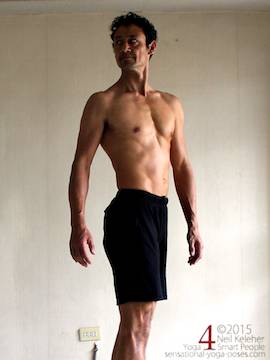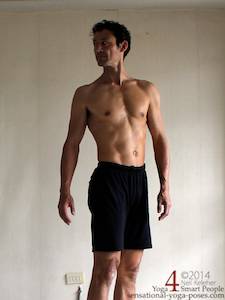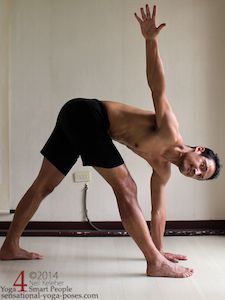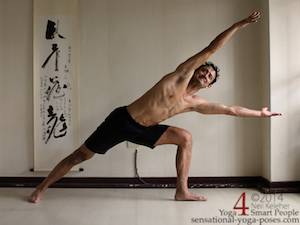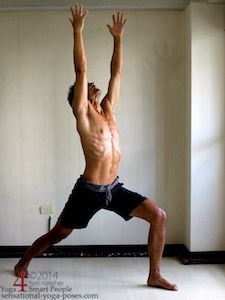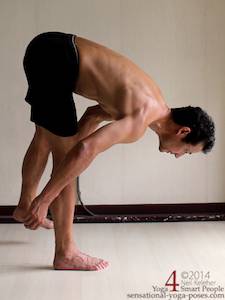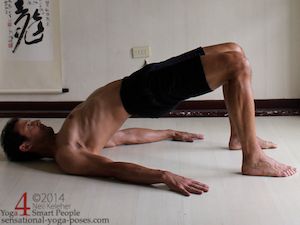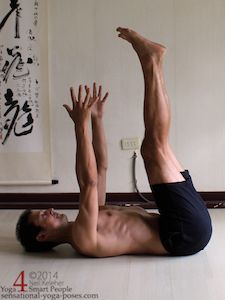Hip Stability Exercises
Stabilizing the hips in standing poses to deal with low back pain
When trying to deal with low back pain a lot of people recommend working on the abs. My own feeling is that since I experience low back pain mostly while standing, a better solution is to work on improving hip muscle control and hip stability while standing.
The better I can control my hip muscles while I am standing, the better I can use them to stabilize my hip bones relative to my thigh bones. Then my abs have a stable foundation from which to work on stabilizing and controlling the spine and ribcage.
Rather than doing these exercises while laying down, I like to do hip stability exercises while standing to improve my ability to deal with low back pain.
Standing Hip Turn
To make it easier to do hip stability exercises one of the first things that I do with my students is an exercise to enable them to better feel and control their pelvis while standing. And so I have them practice turning their pelvis to one side while standing with weight even on both feet with knees slightly bent.
Rather than just turning the pelvis to the right and left the exercise is to slowly turn the pelvis to the right while focusing on feeling the mass of the pelvis. Then I have them turn it back to the front. The next exercise is to then repeat these actions while standing on one foot.
Standing Yoga Twist
Once they are used to feeling and controlling the pelvis with this simple exercise, the next exercise is to practice turning the ribcage relative to the pelvis while standing on both legs. Here the goal is to use the hip muscles to keep the pelvis stable while using the abs and intercostals to twist and turn the ribcage relative to the pelvis.
To increase the work in this hip stability exercise I then have my students doing it while standing on one leg.
Revolving Triangle Yoga Pose
A yoga pose where both actions can be practiced is Revolving Triangle. While bent forwards and twisting to the side the idea is to stabilize the hips (using the experience from the standing hip turn and the standing ribcage twist) while using the abs to turn the ribcage relative to the pelvis.
Going back to the standing hip turn, the idea of this exercise is to feel the action of the hip muscles while turning the pelvis. Then instead of using the hip muscles to turn the pelvis, in revolving triangle use the actions of internal rotation and external rotation of the hip against each other to keep the hip stable.
Standing Side Bend
Another favorite hip stability exercise is the standing side bend. This isn't so much a hip stabilizing action as it is an action for learning to feel the muscles that work on the hips and legs. For this exercise the idea is to engage the muscles on the short side of the body while opening or stretching the long side of the body. The action that is most applicable to hip stability is squeezing the side of the thigh and buttock.
This action can then be used in a pose like triangle pose. In one of the variations that I teach I like to have my students engage the outer thigh of the "back leg" (the front leg is the leg that you are leaning towards) prior to lifting the hand and reaching both hands past the ears.
Side Angle Yoga Pose
I've recently been dealing with both old and new knee problems and one of the things that I'm rediscovering is that the knee affects the hip and vice versa. To that end hip stability exercises should also include some knee awareness and knee control exercises.
To that end I like to do side angle pose. One way to practice knee awareness is with the knees straight engage the outer thigh of the back leg. Then slowly bend the front knee. By slowly I mean take at least 5 seconds to bend it completely (so that thigh is horizontal or nearly so) and another 5 or more to straighten the knee again.
I like to slowly straighten and bend the knee while keeping the pelvis and ribcage tilted towards the front leg. After a few repetitions then I add the arms in, reaching one arm or both arms to the side while bending the knee and then relaxing them when straightening the knee.
Warrior 1
Another bent knee hip stability exercise is Warrior 1.
For this exercise make the back knee feel "strong". Squeeze the front, sides and back of the back knee. Then slowly bend the front knee while bending the thoracic spine backwards and lifting and expanding the ribcage. Then slowly straighten the knee and allow the thoracic spine to bend forwards.
After a few repetitions I'll add an arm lift, reaching the arms to the side and up as the knee bends and the chest opens, lowering the arms as the knee returns to being straight.
Standing Forward Bend on One Leg
One of my favorite hip stability exercises is to bend forwards and then shift weight to one foot. Both hands can be on the floor initially. After shifting weight to one foot, lift the other foot. Then shift back far enough that the arms relax. Press the toes down and stabilize the feet and ankles (and stabilize the hip joint) and then lift both hands.
Keep the lifted leg parallel with the standing leg. Don't reach it back. Instead work at pulling it forwards.
Bridge Yoga Pose
One Supine Pose yoga pose you can use for hip stability is bridge yoga pose. Focus on squeezing the buttocks to press the hips up to the ceiling. You can also focus on pressing the feet down.
Afterwards reach the arms and legs up while laying on your back.
